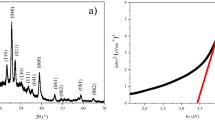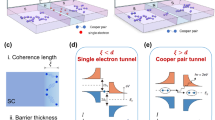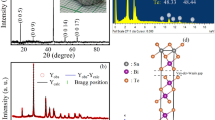Abstract
Thermoelectric properties of AA-stacked bilayer SiC in presence of a magnetic field and a bias voltage were studied using the tight binding model. Green function method was applied to calculate thermal conductivity and Seebeck coefficient under the influence of bias voltage and external magnetic field within the linear response theory. We obtained that the effect of bias voltage is to increase energy gap of the bilayer SiC, unlike the magnetic field effect. Thermal conductivity and Seebeck coefficient of bilayer SiC depend on magnetic field and bias voltage. We obtained that the Seebeck coefficient sign is positive, which means the charge carriers are holes, in the whole range of temperature for different values of applied bias voltage and applied magnetic field. Also, the peak appeared in temperature dependence of thermal conductivity, Seebeck coefficient, and figure of merit ZT decreased with bias voltage. Finally, we investigated the effects of applying magnetic field on Seebeck coefficient and thermal conductivity of AA-stacked bilayer SiC in details.
Similar content being viewed by others
References
Brar VW, Zhang Y, Yayon Y, Ohta T, McChesney JL, Bostwick A, Rotenberg E, Horn K, Crommie MF (2007) Scanning tunneling spectroscopy of inhomogeneous electronic structure in monolayer and bilayer graphene on SiC. Appl Phys Lett 91:122102
Shahrokhi M (2017) Quasi-particle energies and optical excitations of novel porous graphene phases from first-principles many-body calculations. Diam Relat Mater 77:35–40
Shahrokhi M (2017) Tuning the band gap and optical spectra of monolayer penta-graphene under in-plane biaxial strains. Optik: 205–214.
Shahrokhi M, Leonard C (2017) Tuning the band gap and optical spectra of silicon-doped graphene: Many-body effects and excitonic states. Alloys Compd 693:1185–1196
Shahrokhi M (2019) Can fluorine and chlorine functionalization stabilize the graphene like borophene? Comput Mater Sci 156:56–66
Shahrokhi M, Mortazavi B (2018) Lithium halide monolayer sheets: First-principles many-body calculations. Comput Mater Sci 143:103–111
Mortazavi B, Shahrokhi M, Xe Z, Rabczuk T (2018) Boron-graphdiyne: superstretchablesemiconductor with low thermal conductivity and ultrahigh capacity for Li, Na and Ca ions storage. J Mater Chem A 6:11022–11036
Xu M, Liang T, Shi M, Chen H (2013) Graphene-like two-dimensional materials. Chem Rev 113:3766–3798
Zhong X, Yap YK, Pandey R, Karna SP (2011) First-principles study of strain-induced modulation of energy gaps of graphene/BN and BN bilayers. Phys Rev B 83:193403
Chegel R (2017) Bias induced modulation of electrical and thermal conductivity and heat Capacity of BN and BN/graphene bilayers. Physica B 511:26–35
Hoi BD, Mirabbaszadeh K, Habibiyan H, Yarmohammadi M (2017) Optical Absorption of SiC, BN, and BeO Nanosheets in Holstein Model. J. Supercond Nov Magn 30:2435–2444
Tabert CJ, Nicol EJ (2012) Dynamical conductivity of AA-stacked bilayer graphene. Phys Rev B 86:075439
Kadi F, Malic E (2014) Optical properties of Bernal-stacked bilayer graphene: a Theoretical study. Phys Rev B 89:045419
Liu CC, Feng W, Yao Y (2011) Quantum spin Hall effect in silicene and two-dimensional germanium. Phys Rev Lett 107:076802
Persson C, Lindefelt U (1996) Detailed band structure for 3C-, 2H-, 4H-, 6H-SiC, and Si around the fundamental band gap. Phys Rev B 54:10257
Morkoc H, Strite S, Gao GB, Lin ME, Sverdlov B, Burns M (1994) Large-band-gap SiC, III-V nitride, and II-VI ZnSe-based semiconductor device technologies. J Appl Phys 76:1363
Ettisserry D, Goldsman N, Lelis A (2014) A methodology to identify and quantify mobility-reducing defects in 4H-silicon carbide power metal-oxide-semiconductor field-effect transistors. J Appl Phys 115:103706
Bekaroglu E, Topsakal M, Cahangirov S, Ciraci S (2010) First-principles study of defects and adatoms in silicon carbide honeycomb structures. Phys Rev B 81:075433
Shin H, Cahangirov S, Topsakal M, Bekaroglu E, Akturk E, Senger RT, Ciraci S (2009) Monolayer honeycomb structures of group-IV elements and III-V binary compounds: First-principles calculations. Phys Rev B 80:155453
Gao BL, Wang B, Xu QQ, Xiong SJ (2011) Ferromagnetic and antiferromagnetic properties of the fluorinated bilayer SiC sheets. Phys E 43:1394–1397
Sahin H, Cahangirov S, Topsakal M, Bekaroglu E, Akturk E, Senger RT, Ciraci S (2009) Monolayer honeycomb structures of group-IV elements and III-V binary compounds: First-principles calculations. Phys Rev B: Condens Matter Mater Phys 80:155453
An Z, Zhang R, Fang D (2019) Synthesis of monolithic SiC aerogels with high mechanical strength and low thermal conductivity. Ceram Int 45(9):11368–11374
Zheng Q, Li C, Rai A, Leach JH, Broido DA, Cahill DG (2019) Thermal conductivity of GaN, 71GaN, and SiC from 150 K to 850 K. Phys Rev Mater 3:014601
Fukuda S, Kato T, Okamoto Y, Nakatsugawa H, Kitagawa H, Yamaguchi S (2011) Thermoelectric Properties of Single-Crystalline SiC and Dense Sintered SiC for Self-Cooling Devices. Jpn J Appl Phys 50:031301
Li BL, Chen KQ (2017) Effects of electron-phonon interactions on the spin-dependent Seebeck effect in graphene nanoribbons. Carbon 119:548–554
Rezania H, Ghorlivand VA (2018) Seebeck coefficient and thermal conductivity of doped armchair graphene nanoribbon in the presence of magnetic field. Mater Res Bull 99:18–22
Rezania H, Azizi F (2018) The effects of transverse magnetic field and local electronic interaction on thermoelectric properties of monolayer graphene. Solid State Commun 270:65–71
Abbasi A, Rezania H (2019) Electrical conductivity of undoped bilayer Graphene: Beyond nearest neighbor approximation. Chem Phys 525:110384
Li HP, Zhang RQ (2012) Vacancy-defect–induced diminution of thermal conductivity in silicone. Europhys Lett 99:36001
Hu M, Zhang X, Poulikakos D (2013) Anomalous thermal response of silicene to uniaxial stretching. Phys Rev B 87:195417
Zhang X, Xie H, Hu M, Bao H, Yue S, Qin G, Su G (2014) Thermal conductivity of silicene calculated using an optimized Stillinger-Weber potential. Phys Rev B 89:054310
Xie H, Hu M, Bao H (2014) Thermal conductivity of silicene from first-principles. Appl Phys Lett 104:131906
Mahan G D (2013) Many-particle physics. Springer Science & Business Media.
Grosso G, Parravicini GP (2000) Solid State Physics. Academic Press, London
Nolas G S, Sharp J, Goldsmid J (2001) Thermoelectrics: Basic Principles and New Materials Developments, Springer.
Paul I, Kotliar G (2003) Thermal transport for many-body tight-binding models. Phys Rev B 67:115131
Chegel R (2017) Bias induced modulation of electrical and thermal conductivity and heat capacity of BN and BN/graphene bilayers. Phys B Condens Matter 511:26–35
Rezania H, Nouri E (2018) Static thermal conductivity of doped gapped graphene like structure in the presence of magnetic field. Comput Condens Matt 16:e00298
Markov M, Hu X, Liu HC, Liu N, Poon SJ, Esfarjani K, Zebarjadi M (2018) Semi-metals as potential thermoelectric materials. Sci Rep 8:9876
Author information
Authors and Affiliations
Corresponding author
Additional information
Publisher’s Note
Springer Nature remains neutral with regard to jurisdictional claims in published maps and institutional affiliations.
Rights and permissions
About this article
Cite this article
Abdi, M., Astinchap, B. Influence of Magnetic Field and Bias Voltage on the Thermal Conductivity and Seebeck Coefficient of AA-Stacked Bilayer SiC. Silicon 13, 1223–1230 (2021). https://doi.org/10.1007/s12633-020-00501-6
Received:
Accepted:
Published:
Issue Date:
DOI: https://doi.org/10.1007/s12633-020-00501-6




